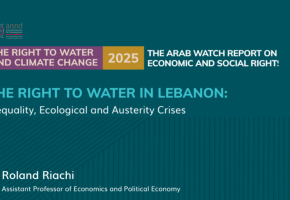
Challenging Mainstream Sovereign Debt Narratives: A Rights-Based Approach for the Arab Region - Hassan Sherry

Challenging Mainstream Sovereign Debt Narratives: A Rights-Based Approach for the Arab Region - Hassan Sherry
Arab countries, like their Global South counterparts, risk defaulting on the Sustainable Development Goals (SDGs) and climate commitments. According to the 2024 World Investment Report, there is a $4 trillion investment gap needed to meet the SDGs in developing countries, and the drop in international project finance will exacerbate this shortfall. In the Arab region, 14 countries have yet to achieve a single SDG target. According to the UN Economic and Social Commission for Western Asia (ESCWA), this lack of progress will extend the 2030 deadline for achieving the SDGs by an additional 60 years.
The main culprit is the significant rise in debt stocks and debt servicing levels, particularly when such increases come at the expense of social spending on public goods such as education, health coverage, and other requirements for advancing the SDGs.
Despite this situation, the mainstream focus is shifting from solvency risks (and the need to improve debt restructuring processes) to a narrative of a 'short-term liquidity crunch,' with calls for increased financing to reverse negative net financial flows and for rescheduling without real debt cancellation. Some institutions, including the IMF and the World Bank, argue that solvency risks are broadly contained. However, the reality is that billions of people are living through a full-blown debt crisis, including in the Arab region.
This article contends that such claims oversimplify a far more complex reality. It aims to provide a rights-based appraisal of the nature and determinants of sovereign debt challenges in the Arab region and to discuss the features of an alternative debt management framework that ensures debt supports development. Specifically, the article seeks to answer the following set of questions:
1) Is debt in the Arab region sustainable?
2) Do existing debt sustainability analyses (DSAs) adequately capture the nature of the problem?
3) What should debt relief in the Global South, including in the Arab region, look like?
Overview of debt sustainability in the region
The ratio of public debt to GDP in the Arab region, excluding Gulf Cooperation Council (GCC) member states, reached an average of 71% in 2022, exceeding the averages for both developing and least developed countries (LDCs). Additionally, the ratio of external public debt surpassed the averages for developed, developing, and LDCs. Over the past decade, public debt interest payments as a percentage of revenues have risen significantly in at least six Arab countries, reaching nearly 50% in Lebanon and Egypt in recent years. This alarming debt situation has been further exacerbated by a sharp 42.6% decline in concessional lending during the same period, while total debt service surged by 82.4%.
In mainstream discourse, International Financial Institutions (IFIs) and Multilateral Development Banks (MDBs), including the IMF, argue that fewer defaults are occurring and that countries continue to service their debts. However, two important caveats must be noted.
First, the lower number of defaults is largely due to lending arrangements with IFIs that compel indebted countries to implement severe cuts in public spending. These austerity measures often worsen existing vulnerabilities, particularly in nations where public spending is already in decline. In countries exposed to climate-related shocks, such spending cuts can further trigger social unrest and destabilization.
Second, the fact that fewer countries are defaulting could shift abruptly, especially given the ongoing wars in the Middle East and the risk of these wars spreading across the region.
Against this backdrop, civil society organizations (CSOs) in the Arab region are emphasizing a critical message: there is a debt crisis. Many countries in the region are on the brink of debt unsustainability.
This crisis is not merely about liquidity versus solvency, nor is it solely about defaults. More significantly, it is evident in cuts to government budgets and reductions in spending on public goods that are fundamental human rights, including health, quality education, infrastructure, and climate mitigation. It is also reflected in the economic recession affecting many countries in the region, driven by the exceptionally high and escalating debt service levels compared to previous decades.
Recent publications

Neoliberalism and Feminist Discourse: Between Assimilation and Resistance in the Arab Context
